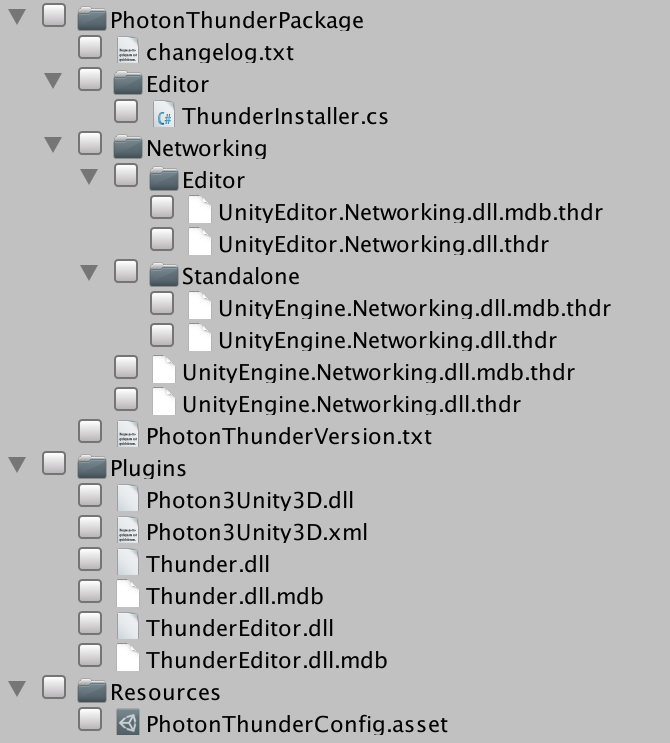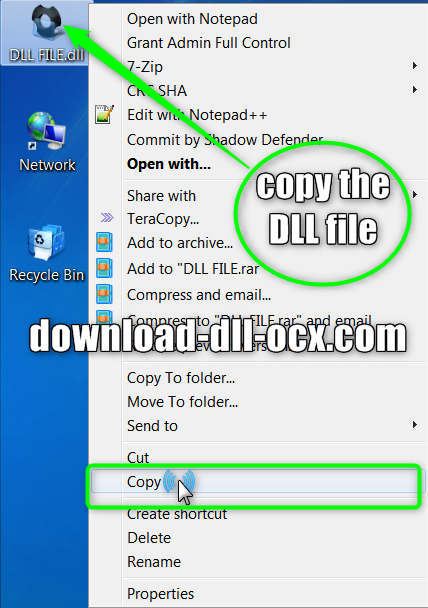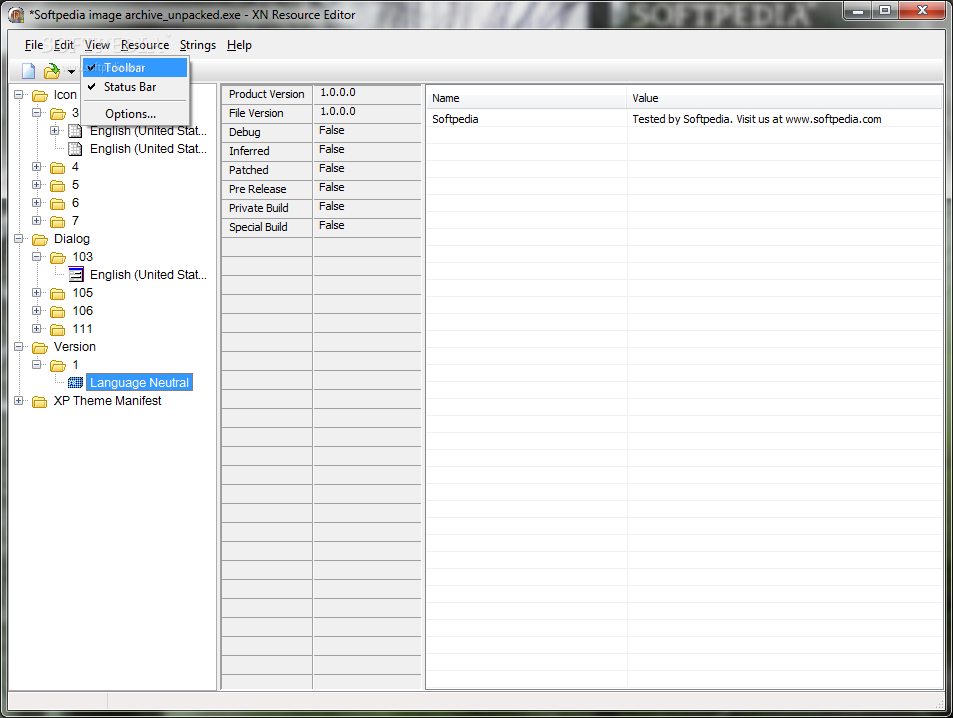Powerful icon editor and cursor maker to edit icons, cursors and small web graphics. You can create icons from images of 25 formats or edit icons in exe, dll or icl. Supports 60 image filters, desktop capture, Vista icon editing and more.
- iconed6.exe
- Newera Software TechnologyInc.
- Freeware ($)
- 12.27 Mb
- Win2000, Win7 x32, Win7 x64, Win98, WinServer, WinVista, WinVista x64, WinXP
With this editor it is possible to build EXE file independent resource files which can be read by any project over a DLL at runtime. Multiple example projects included that show you handling of the DLL. For .NET Framework 1.1/2.0 in C#/VB. Also VB 6.
- RDEdit.exe
- Andreas Breitschopp
- Shareware ($)
- 491 Kb
- Win98, WinME, WinNT 4.x, WinXP, Windows2000, Windows2003
XN Resource Editor Portable is the lightweight XN Resource Editor packaged as a portable app, so you can modify resources, change dll, change icons, recover icons, and change dialog boxes on the go. XNResourceEditor works with all resource files. ...
- XNResourceEditorPortable_3.0.0.1_English.paf.exe
- Portableapps
- Freeware (Free)
- 1.1 Mb
- WinXP, Windows Vista, Windows 7, Windows 7 x64
A complete line-based ANSI text editor in a dll file with full and open source code. Programmed entirely in Assembler for Win32 with Easy Code (Easy Code is a real visual assembler IDE available for free). The editor has all functions (copy, paste, search, replace).
- RSEditor.zip
- easycode
- Shareware ($)
- 163 Kb
- WinXP, Win2000, Win Vista, Windows 7
Hex and Binary Code Data Editing Software Utility for Windows. Hex Editor Neo is a basic editor for everyone who works with ASCII, hex, decimal, float, double and binary data. Large files optimized, best performance. We are saving your precious time. ...
- hex-editor-neo.exe
- HHD Software
- Shareware ($39.99)
- 5.47 Mb
- WinXP, Windows2000, Windows2003, Windows Vista
View, Modify and Analyze your Hexadecimal Data and Binary Files of any Size. Free Hex Editor Neo is a large files optimized freeware editor for everyone who works with ASCII, hex, decimal, float, double and binary data. ...
- free-hex-editor-neo.exe
- HHD Software
- Freeware (Free)
- 5.47 Mb
- WinXP, Windows2000, Windows2003, Windows Vista
With this editor it is possible to build EXE file independent resource files which can be read by any project over a DLL at runtime. Multiple example projects are included that show you the handling of the DLL file. Embedding within C# and also. ...
- RDEdit.exe
- Andreas Breitschopp
- Shareware ($79.00)
- 810 Kb
- Win98, WinME, WinNT 4.x, WinXP, Windows2000, Windows2003, Windows Tablet PC Edition
VeCAD is a 3D vector graphics library. It serves as a foundation for your own customized drawing applications (CAD/GIS). The library is furnished in two discreet formats; as a run-time Windows 32 bit DLL; and, as an OCX (ActiveX control). Both are. ...
- vecad6.zip
- Kolbasoft
- Shareware ($499.00)
- 3.5 Mb
- Windows All
Abdio Hex Editor is an easy-to-use and powerful hex editor to edit hex files with search, drag and drop, and search and replace capabilities. Edit your Exe, Dll and other files with Abdio Hex Editor. Abdio Hex Editor is one friendly Hex data editor,. ...
- Abdio HEX Editor
- Abdio, Inc.
- Shareware ($29.95)
- 2.59 Mb
- Windows Vista, 2003, XP, 2000, 98, Me
CAD-KAS PDF Editor 3.0 allows you to write annotations, add text, change the text (correct spelling errors) or delete words completely. You can also add or delete pictures and vector graphics and add text in any font you want! With the 11 new tools. ...
- CAD-KAS PDF Editor
- CAD-KAS GbR
- Trial ($79.00)
- 4.2 Mb
- Windows 7, Windows Server 2003, Windows 2000
DMT SQL Editor 1.1 is an effective program which allows you to execute SQL queries and scripts development quickly and simply.It is a good choice for everyone who need edit SQL scripts with a convenient easy-to-use interface.Major Features:Support. ...
- DMT SQL Editor
- DMT Software Inc
- Freeware (Free)
- 2 Mb
- Any Platform
ICON Editor is a small and easy-to-use icon editing program. It allows you editing a transparent or opaque icon. The sizes may be 16 X 16, 32 X 32, 48 X 48, 64 X 64 or custom it as you like. The colors may be Monochrome(1 bit), 16 colors(4 bits), 256. ...
- iconmaker.exe
- icon-editor.net
- Shareware ($29.95)
- 1.56 Mb
- Windows XP, 2000, 98, Me, NT


Related:
Licensing for the POV-Ray for Windows Editor DLL's. The editor component of POV-Ray for Windows is not licensed under the AGPL3. Until such time as the editor is replaced with one that has a license compatible with the rest fo the POV-Ray 3.7 distribution, it is only available as a separate download under the license that applied to the. Open DLL file with text editor or a hex editor. Check if the first two symbols in the file are MZ and the rest are binary symbols. If it is so and extension of the file is DLL then most probably it is a real DLL file. Below is an example of DLL file opened in Dependency Walker in Windows OS. You can also look with a hex editor at the.dll, inside it there might be references to source files If the.dll has dependencies in form of msvcr### (d).dll (# sign is a placeholder for a digit) or vcruntime### (d).dll, then it's C, if it also has msvcp### (d).dll, then it's C (created with VStudio).
Dll Editor Dll - Pe Dll Editor - Dll Editor - Dll Resource Editor - Dll Javascript EditorFree Dll Editor
-->In Windows, a dynamic-link library (DLL) is a kind of executable file that acts as a shared library of functions and resources. Dynamic linking is an operating system capability. It enables an executable to call functions or use resources stored in a separate file. These functions and resources can be compiled and deployed separately from the executables that use them.
A DLL isn't a stand-alone executable. DLLs run in the context of the applications that call them. The operating system loads the DLL into an application's memory space. It's done either when the application is loaded (implicit linking), or on demand at runtime (explicit linking). DLLs also make it easy to share functions and resources across executables. Multiple applications can access the contents of a single copy of a DLL in memory at the same time.
Differences between dynamic linking and static linking
Static linking copies all the object code in a static library into the executables that use it when they're built. Dynamic linking includes only the information needed by Windows at run time to locate and load the DLL that contains a data item or function. When you create a DLL, you also create an import library that contains this information. When you build an executable that calls the DLL, the linker uses the exported symbols in the import library to store this information for the Windows loader. When the loader loads a DLL, the DLL is mapped into the memory space of your application. If present, a special function in the DLL, DllMain, is called to do any initialization the DLL requires.
Differences between applications and DLLs
Even though DLLs and applications are both executable modules, they differ in several ways. The most obvious difference is that you can't run a DLL. From the system's point of view, there are two fundamental differences between applications and DLLs:
An application can have multiple instances of itself running in the system simultaneously. A DLL can have only one instance.
An application can be loaded as a process. It can own things such as a stack, threads of execution, global memory, file handles, and a message queue. A DLL can't own these things.
Dll Editor Download
Advantages of using DLLs
Dynamic linking to code and resources offers several advantages over static linking:
Dynamic linking saves memory and reduces swapping. Many processes can use a DLL simultaneously, sharing a single copy of the read-only parts of a DLL in memory. In contrast, every application that is built by using a statically linked library has a complete copy of the library code that Windows must load into memory.
Dynamic linking saves disk space and bandwidth. Many applications can share a single copy of the DLL on disk. In contrast, each application built by using a static link library has the library code linked into its executable image. That uses more disk space, and takes more bandwidth to transfer.
Maintenance, security fixes, and upgrades can be easier. When your applications use common functions in a DLL, you can implement bug fixes and deploy updates to the DLL. When DLLs are updated, the applications that use them don't need to be recompiled or relinked. They can make use of the new DLL as soon as it's deployed. In contrast, when you make fixes in statically linked object code, you must relink and redeploy every application that uses it.
You can use DLLs to provide after-market support. For example, a display driver DLL can be modified to support a display that wasn't available when the application was shipped.
You can use explicit linking to discover and load DLLs at runtime. For example, application extensions that add new functionality to your app without rebuilding or redeploying it.
Dynamic linking makes it easier to support applications written in different programming languages. Programs written in different programming languages can call the same DLL function as long as the programs follow the function's calling convention. The programs and the DLL function must be compatible in the following ways: The order in which the function expects its arguments to be pushed onto the stack. Whether the function or the application is responsible for cleaning up the stack. And, whether any arguments are passed in registers.
Dynamic linking provides a mechanism to extend the Microsoft Foundation Class library (MFC) classes. You can derive classes from the existing MFC classes and place them in an MFC extension DLL for use by MFC applications.
Dynamic linking makes creation of international versions of your application easier. DLLs are a convenient way to supply locale-specific resources, which make it much easier to create international versions of an application. Instead of shipping many localized versions of your application, you can place the strings and images for each language in a separate resource DLL. Then your application can load the appropriate resources for that locale at runtime.
A potential disadvantage to using DLLs is that the application isn't self-contained. It depends on the existence of a separate DLL module: one that you must deploy or verify yourself as part of your installation.
More information on how to create and use DLLs
The following articles provide detailed information about how to create C/C++ DLLs in Visual Studio.

Walkthrough: Creating and using a dynamic link library (C++)
Describes how to create and use a DLL using Visual Studio.
Kinds of DLLs
Provides information about the different kinds of DLLs that can be built.
DLL frequently asked questions
Provides answers to frequently asked questions about DLLs.
Link an executable to a DLL
Describes explicit and implicit linking to a DLL.

Initialize a DLL
Discusses DLL initialization code that must execute when your DLL loads.
DLLs and Visual C++ run-time library behavior
Describes the run-time library DLL startup sequence.
LoadLibrary and AfxLoadLibrary
Discusses using LoadLibrary and AfxLoadLibrary to explicitly link to a DLL at runtime.
GetProcAddress
Discusses using GetProcAddress to obtain the address of an exported function in the DLL.
FreeLibrary and AfxFreeLibrary
Discusses using FreeLibrary and AfxFreeLibrary when the DLL module is no longer needed.
Dynamic-Link Library Search Order
Describes the search path that the Windows operating system uses to locate a DLL on the system.
Module states of a regular MFC DLL dynamically linked to MFC
Describes the module states of a regular MFC DLL dynamically linked to MFC.
MFC extension DLLs
Explains DLLs that typically implement reusable classes derived from the existing MFC classes.
Dll Editor Program
Creating a resource-only DLL
Discusses a resource-only DLL, which contains nothing but resources, such as icons, bitmaps, strings, and dialog boxes.
Localized resources in MFC Applications: Satellite DLLs
Provides enhanced support for satellite DLLs, a feature that helps in creating applications localized for multiple languages.
Importing and exporting
Describes importing public symbols into an application or exporting functions from a DLL
Active technology and DLLs
Allows object servers to be implemented inside a DLL.
Automation in a DLL
Describes what the Automation option in the MFC DLL Wizard supplies.
Dll Editor Software
Naming conventions for MFC DLLs
Discusses how the DLLs and libraries included in MFC follow a structured naming convention.
Dll Editor Download

Calling DLL functions from Visual Basic applications
Describes how to call DLL functions from Visual Basic applications.
Related Sections
Using MFC as part of a DLL
Describes regular MFC DLLs, which let you use the MFC library as part of a Windows dynamic-link library.
DLL version of MFC
Describes how you can use the MFCxx.dll and MFCxxD.dll (where x is the MFC version number) shared dynamic-link libraries with MFC applications and MFC extension DLLs.